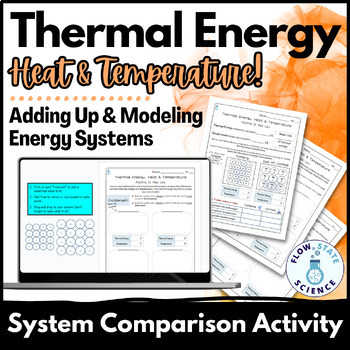Thermal Energy Heat and Temperature | Adding and Modeling Systems | Interactive
- Google Drive™ folder
- Easel Activity

Also included in
- This self-grading Google Form lesson with printable/digital modeling activities focuses on reading, modeling, and comparing thermal energy and temperature systems! Using NGSS language, students use and develop models to mathematically compare total kinetic energy and average kinetic energy of energyPrice $9.99Original Price $11.25Save $1.26
- This bundle includes all resources in my store within the THERMAL ENERGY unit at a 30% discount! This includes topics of heat, temperature, thermal energy, conduction, convection, radiation, states of matter, phase changes & kinetic molecular theory as well as the Are Cats Liquids CER lesson (UnPrice $35.45Original Price $50.65Save $15.20
- These NGSS aligned resources are perfect to supplement learning about thermal energy, heat, temperature and thermal energy transfer (convection, conduction and radiation). All resources in this bundle include guided and non guided, differentiated options to accommodate all learners as well as flexibPrice $18.60Original Price $23.25Save $4.65
- This bundle includes an auto-graded google form, two worksheet activities and sketch notes for science doodles! Students compare/contrast similarities and differences of thermal energy, heat and temperature using models (see below for more details). The interactive sketch notes can be printed or assPrice $12.00Original Price $15.00Save $3.00
- This bundle includes all my STORE RESOURCE BUNDLES rolled into one at a 30% discount! Most resources are formatted in Google Drive, are low/no prep, and are ready to print or assign to students in an LMS.This HUGE bundle includes my store resource bundles for the following units and topics:1. Non-coPrice $149.14Original Price $213.05Save $63.91
Description
Students use mathematical and computational thinking with these digital interactive, printable worksheets to learn the difference between thermal energy, heat, and temperature! Students mathematically compare the differences between total kinetic energy (thermal energy) and average kinetic energy (temperature) by using and developing models of energy systems.
By the end of this lesson, students will be able to answer the question, "What is the difference between thermal energy, heat and temperature?"
Concepts: Kinetic Energy, Thermal Energy, Heat, Temperature, Finding Average, Joule
This resource is aligned with the CK12 Reading: Thermal Energy, Heat & Temperature. What's the Difference? Covers Kinetic Molecular Theory and the difference between heat, temperature and thermal energy.
✔ Minimal Prep - Digitally Ready to assign to an LMS or print
✔ Students can check their answers using the Thermal Energy, Heat & Temperature | Self Grading Google Form Lesson --> Get them both HERE!
= = = = = = = = = = ===== = = = = = = = = = = =
NGSS Alignment
= = = = = = = = = = ===== = = = = = = = = = = =
Performance Expectation: MS-PS3-4 Energy
- Plan an investigation to determine the relationships among the energy transferred, the type of matter, the mass, and the change in the average kinetic energy of the particles as measured by the temperature of the sample.
Disciplinary Core Ideas: PS3.A: Definitions of Energy
- Temperature is a measure of the average kinetic energy of particles of matter. The relationship between the temperature and the total energy of a system depends on the types, states, and amounts of matter present.
Crosscutting Concepts: Scale, Proportion, and Quantity
- Proportional relationships (e.g. speed as the ratio of distance traveled to time taken) among different types of quantities provide information about the magnitude of properties and processes.
= = = = = = = = = = ===== = = = = = = = = = = =
Adding it All Up & Modeling Systems Printable/Interactive Handouts
= = = = = = = = = = ===== = = = = = = = = = = =
✔ Student Versions - Non editable & ready to assign digitally with textboxes set up!
✔ Teacher Versions - Editable with Answer Key
Adding It All Up! Page:
*If completed digitally, students follow instructions to interact with the drag-and-drop items in the margin. The pages are still printable.
Students will:
- Define the main scientific differences between thermal energy, heat and temperature by filling in the blanks.
- Use mathematical & computational thinking to compare the differences between thermal energy & temperature using system models representing molecules and the energy in an iceberg & cup of hot coffee.
- Identify which system has greater thermal energy, temperature & kinetic energy.
Modeling Systems Challenge Page:
Includes Modified/Differentiated Version for Lower Level Students by completing one challenge instead of both!
Students will:
- Develop a model of 2 systems with a different number of molecules, but the same amount of thermal energy
- Develop a model of 2 systems with a different number of molecules, but the same temperature
⏩ Get the Self-Grading Thermal Energy Heat and Temperature Google Form Lesson by itself --> HERE!
⏩ Save $ and get both: Interactive Handouts + accompanying self-grading Google Form Lesson --> HERE!
= = = = = = = = = = ===== = = = = = = = = = = =
✅ This download includes a Google Drive Folder which contains:
= = = = = = = = = = ===== = = = = = = = = = = =
- Teacher - Adding it All Up! - Includes Key (2 pgs + TOU)
- Teacher - Modeling Systems - Includes modified page & Key (3 pgs + TOU)
- Student - Adding it all up & Modeling Systems Handouts (2 pgs)
- Student - *Modified* Adding it all up & Modeling Systems Handouts (2 pgs)
*Student versions are non editable & ready to assign
*Teacher versions include editable copies and answer key
= = = = = = = = = = ===== = = = = = = = = = = =
Google Form™ Lessons: The "Bells & Whistles"
= = = = = = = = = = ===== = = = = = = = = = = =
I have absolutely purchased sub-par google forms before where they didn't come with an answer sheet and weren't even auto graded (what?!). You won't get sub-par here. These Google form lessons are designed for you for in class digital, at home distance learning or both!
Students *thrive* on that instant feedback!
The forms are auto-graded and give a raw score for objective questions, but there are also subjective critical thinking questions that are ungraded! This encourages more in-depth student thinking and teacher insight of student learning than a "typical" auto-graded assignment.
Flow State Google Forms™:
- Are high-quality forms designed to be fully functional and interactive for teacher and student efficiency.
- Include all the “bells and whistles” such as guiding pictures, response validations, auto-grade, feedback on specific questions for specific answers, answer keys, videos, checklists, links, shuffled questions when appropriate, simulations, fill in the blank, short answer and long answer critical thinking questions.
- May include formative questions at the beginning & end of form to allow students to reflect upon their own learning as well.
- Typically involve a lab simulation to tinker with using the form as a guide and check for understanding.
- Include a student survey at the end of each form for students to indicate the difficulty level of the assignment and leave a note for the teacher (the sweet notes are so helpful!)
I began developing Google Form style lessons to help me complete labs and teach concurrently during the pandemic. The positive feedback and successful results I observed from students encouraged me to continue creating more. Some can get pretty intricate! The immediate feedback the GForm lessons can provide helps raise student confidence in learning science content --there is research to support this! I encourage you to try a full lesson with your class.
Click HERE to see the Google Form Lessons and Labs I have created so far!
=================================
My mission is to support science teachers with high quality learning resources that increase teacher efficiency, student engagement and classroom flow.
If you appreciate the level of detail (and love ♥ ) put into this product, please show your support by clicking to follow my store and be the first to grab discounts on my new resource drops & freebies!
Keep an eye out as I am frequently adding new goodies as I continue to build my store. New products are 50% off for the first 48 hours! ⏳
You can also show your support by leaving valuable feedback with a brief comment & a quick rating! This helps me determine the best resources for you AND earns you bonus TpT credits! *Click here to see how TpT credits work
Thank you for stopping and I hope you enjoy!
For Our Kids,
The Love of Science
and the Art of Teaching & Learning











